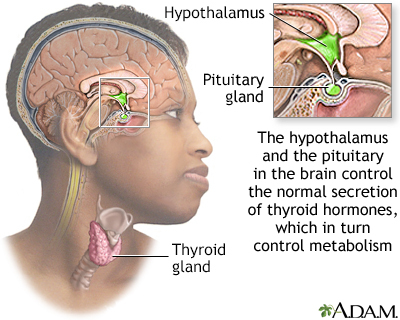Endocrine glands
Definition
Endocrine glands release (secrete) hormones into the bloodstream.
The endocrine glands include:
- Adrenal
- Hypothalamus
- Islets of Langerhans in the pancreas
- Ovaries
- Parathyroid
- Pineal
- Pituitary
- Testes
- Thyroid
Information
Hypersecretion is when an excess of one or more hormone is secreted from a gland. Hyposecretion is when the amount of hormones that are released is too low.
There are many types of disorders that can result when too much or too little of a hormone is released.
Disorders that may be associated with abnormal hormone product from a particular gland include:
Adrenal:
- Addison disease
- Adrenogenital syndrome or adrenocortical hyperplasia
- Cushing syndrome
- Pheochromocytoma
Pancreas:
- Diabetes mellitus
- Hypoglycemia
Parathyroid:
- Tetany (abnormal cramping of muscles)
- Renal calculi (kidney stones)
- Excessive loss of minerals from bone (osteoporosis)
Pituitary:
- Growth hormone deficiency
- Acromegaly
- Gigantism
- Diabetes insipidus
- Cushing disease
Testes and ovaries:
- Lack of sex development (unclear genitalia)
Thyroid:
- Congenital hypothyroidism
- Myxedema
- Goiter
- Thyrotoxicosis
Gallery


References
Barrett EJ. Organization of endocrine control. In: Boron WF, Boulpaep EL, eds. Medical Physiology. 3rd ed. Philadelphia, PA: Elsevier; 2017:chap 47.
Melmed S, Auchus RJ, Goldfine AB, et al. Principles of endocrinology. In: Melmed S, Auchus, RJ, Goldfine AB, Koenig RJ, Rosen CJ, eds. Williams Textbook of Endocrinology. 14th ed. Philadelphia, PA: Elsevier; 2020:chap 1.
Strachan MWJ, Newell-Price JDC. Endocrinology. In: Ralston SH, Penman ID, Strachan MWJ, Hobson RP, eds. Davidson's Principles and Practice of Medicine. 23rd ed. Philadelphia, PA: Elsevier; 2018:chap 18.
